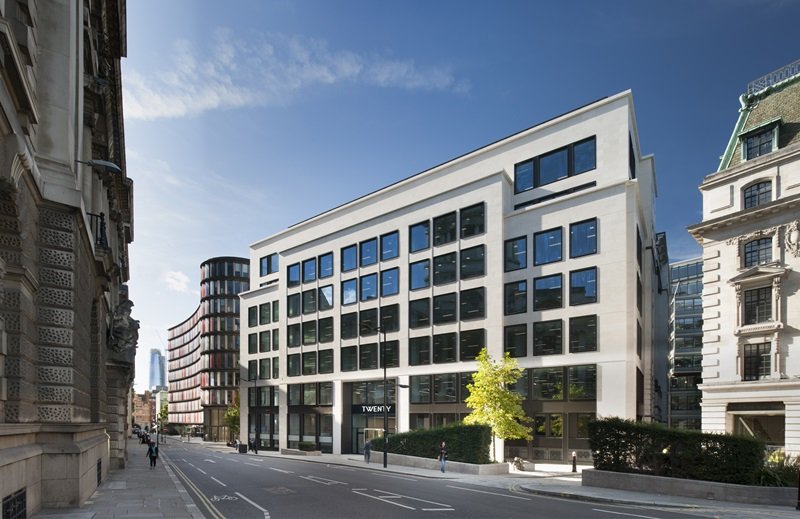
Welcome to 20 Old Bailey
The home of Barings London.
The Old Bailey.
A name that usually crops up in tabloid tales of scandal, shame, and slaughter. If you've ever visited, hopefully, it was just from the public gallery.
The name 'Old Bailey' comes from the street on which the court is located. The road marks the route of the City's original fortified wall (or 'bailey').
'Old Bailey' is only a nickname for what's really called the Central Criminal Court of England and Wales, but ‘Old Bailey’ has always sounded better.
There's been a jail on this site for over 1,000 years, and a court since the 16th century (serving the old Newgate Prison). Various fires and attacks have seen the court rebuilt again and again, and the famous domed Old Bailey we now know only opened in 1907. Some of the bricks in the Old Bailey's façade are repurposed from the demolished Newgate Prison.
Since 1907, thanks to Nazi and later IRA bombings, further major alterations have been made to the Old Bailey. Many of the more recent courtrooms were only added in the 1960s and 70s.
The 22-ton, 3.5m tall figure of Lady Justice is the Old Bailey's crowning glory — clutching the sword of retribution in her right hand, and the scales of justice in the other. But contrary to the well-worn adage, this particular Justice is not blind(folded).
Lady Justice was a symbol of ‘maidenly form’ and this was supposed to guarantee her Impartiality, which renders the blindfold redundant.
The inside of the Old Bailey's dome is apparently incredible, but it only gets to be seen by two people (the Old Bailey's Under-Sheriff and the building manager) and only then, once a year.
Why the dome at all?... It's a doff of the ‘architectural hat’ to nearby St Paul's.
Delve into the depths of the Old Bailey's former coal room, and you'll find a hatch in the floor, beneath which is a ladder leading down to the culverted and famous River Fleet. It is said that prison reformer Elizabeth Fry would collect water here for the inmates, although it is wondered, how much good, drinking water from what was basically a sewer did them!
Dead Man’s Walk.
A grizzly remnant of Newgate Prison is 'dead man's walk'. This is a series of archways that become increasingly smaller, through which condemned prisoners were led on their way to the gallows.
In 1868, at the last public hanging here, 20,000 people came by tube. It is seldom that we associate public hangings and the London Underground!
Charles Dickens was a young court reporter at ‘Old Bailey’ and visited as a regular and the tales he heard sometimes inspired some of his own fiction. Take the case of one Thomas Knight, convicted and deported to New South Wales, he later returned to England — just like Magwitch in Great Expectations…
Some of this country's most notorious trials have happened at the Old Bailey, including those of the Krays (Ronnie was heard to quip to the judge: "If I wasn’t here, I could be having tea with Judy Garland."), Doctor Crippen, an American Homeopath, who murdered his wife, he was the first suspect captured with the aid of wireless telegraphy.
The Yorkshire Ripper, who famously claimed that the ‘voice of god’ had sent him on a mission to kill prostitutes – a murder spree that spanned 5 yrs. There was of course the hanging of Ruth Ellis for shooting her lover numerous times, she was a model and night club owner and the last woman to be executed in Britain. Dig into the archives, and you find some lesser-known, but equally fascinating cases – George Joseph Smith, the ‘Brides in the Bath’ case. George Smith had no less than seven bigamous marriages and deaths! All his wives drowning in their bathtubs. The last Witchcraft Trial was held at Old Bailey and even the ‘Theft of an iced bun and doughnut’ where the defendant was the youngest ever at just 12 yrs old – she was freed by the Judge after her evidence!
You can visit the Old Bailey every weekday for free. However, you will have to ditch your phone as you cannot take mobiles into the courts, 20OB is well placed for this as there is nowhere in or around the courts to leave one’s mobile – perhaps a new business venture for the new building?! Mobile storage…
18 Old Bailey is the site of another famous London landmark – The Public House The Magpie & Stump. It dates from around 1550, the current pub stands on the exact location as the original. Up until public hangings were abolished in 1868, the upstairs rooms were rented out on public holidays, to provide the wealthy with a prime vantage point of the gallows. The speciality on these days was the ‘hanging breakfast’!
In the 17th century the Pub housed one of the clubs known as ‘mughouses’, so called because every drinking man had his own mug.
The last woman hanged publicly was serial killer Catherine Wilson, who was hung with a crowd of 20,000 in October 1862.